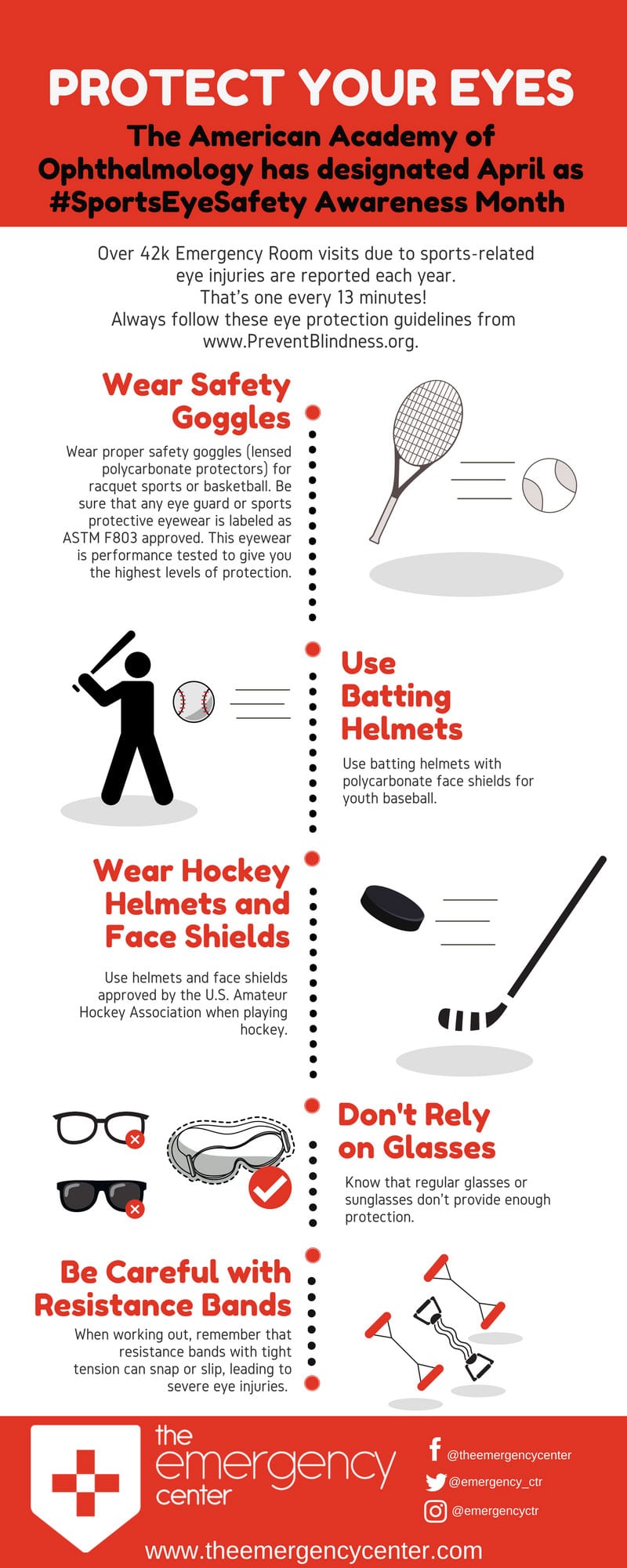April is Sports Eye Safety Awareness Month
According to the American Academy of Ophthalmology (AAO), tens of thousands of sports and recreation related eye injuries occur each year, and 13,500 of these injuries result in permanent vision loss. In support of Sports Eye Safety Awareness Month this April, the American Academy of Ophthalmology reminds athletes everywhere to wear appropriate protective eyewear to avoid sports related eye injuries.
Protective eyewear includes safety glasses and goggles, safety shields and eye guards. Many safety shields and eye guards are designed for particular sports, and should be included in the equip list for all league sports programs.

Sports with Most Eye Injuries
The risks for sports related eye injuries increases with the use of high-speed balls, swinging clubs or bats, close aggressive play, or involve small, high velocity projectiles.
- High-Risk Sports – Baseball/Softball, Martial Arts, Basketball, Paintball, Ice Hockey, Lacrosse, and Racquetball
- Moderate-Risk Sports – Tennis, Soccer, Golf
- Low-Risk Sports – Swimming, Cycling
- Safe Sports – Track and Field, Gymnastics
Eye injuries have also been reported with the use of exercise resistance bands used during gym workouts. These bands should be used with caution, as they can snap or slip suddenly from your grip and fling back towards your face and cause eye injuries.
Sports Eye Injury Prevention
The leading cause of blindness in school-aged children in the United States is due to sports related eye injuries. That’s an estimated 100,000 physician visits per year at a cost of more than $175 million. Approximately 90 percent of serious eye injuries are preventable through use of appropriate eyewear.
So what can you do to help prevent sports related eye injuries?
- Encourage young athletes to wear protective eyewear
- Insist that children wear safety glasses or goggles when playing in youth sport leagues
- Be a positive role model–wear protective eyewear yourself when you engage in sports
- Don’t wear ordinary prescription glasses, contact lenses or sunglasses in lieu of protective eyewear, as they
- Don’t offer sufficient eye protection
- May increase risk of injury (i.e., shattered pieces lodging in your eye)
- Wear sunglasses that filter UVA and UVB sun rays for outdoor sports, such as skiing and waterskiing
- Reduces risk of sun related eye problems (i.e., ocular surface cancer and cataracts)
Guidelines for Purchasing Protective Eyewear
When purchasing protective eyewear, it is recommended that you follow these guidelines:
- Ensure the eyewear fits and is comfortable
- Buy eyewear that is labeled as ASTM (American Society of Testing Materials) F803 Approved
- Make sure the lenses are made of polycarbonate
- Doesn’t reduce vision
- Ultra-Strong
- 10 times more resistant than other plastics
- Highly impact-resistant
- Make sure the level of eye protection is appropriate for the type of activity
You can purchase protective eyewear at sporting goods stores as well as eye care professionals’ offices. The cost for protective eyewear generally ranges from $20 to $40 for basic needs, and may cost $60 or more for prescription lenses.
Seek Immediate Emergency Care for Sports Related Eye Injuries
The AAO also reports that an estimated 42,000 emergency room visits are reported every year due to sports related eye injuries, and every 13 minutes someone is being treated for such trauma. If you have an eye injury, seek immediate emergency care, especially if your eye is swollen shut. You may have a retinal detachment that requires immediate medical attention and surgery. If left untreated, a detached retina can cause blindness. So play it safe and treat any type of eye injury as an emergency.
Sources
- https://www.aao.org/eye-health/tips-prevention/injuries-sports
- https://nei.nih.gov/sports

The Emergency Center
San Antonio
11320 Alamo Ranch Pkwy
San Antonio, TX 78253
Phone: 210-485-3644
Conroe
4019 I-45 N,
Conroe, Texas 77304
Phone: 936-247-9457[/vc_column_text][/vc_column][/vc_row]
